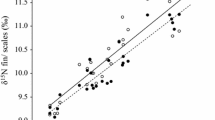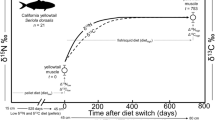Abstract
Many fish species generally migrate among habitats because of ontogenetic changes in their resource requirements; therefore, clarifying linkages among habitats throughout their life cycle is important for the management and conservation of their populations. Although carbon (δ13C) and nitrogen (δ15N) stable isotope ratios are widely used for elucidating fish migrations, information is still scarce how each fish species, including marbled flounder (Pleuronectes yokohamae), change the isotopic composition in their body tissues after they switch to a different diet during migrations. This study clarified isotopic turnover rates of marbled flounder during the juvenile stage using a diet-switch experiment in an aquarium. Furthermore, we statistically compared bulk samples (i.e., whole body without head and viscera) to partial muscle tissue samples to estimate the difference in the turnover rate as an index for diet switches. An exponential model was used to describe the temporal changes in δ13C and δ15N isotopic rates of juvenile marbled flounder. No significant difference was noted between the exponential models for changes in both δ13C and δ15N between muscle tissue and bulk samples, and the half-life values were similar for muscle and bulk samples for both δ13C and δ15N (14.0–18.5 days). These results suggest that bulk samples are a useful substitute for muscle tissues in isotopic analysis of juvenile fish and that stable isotope analysis and the estimated isotopic turnover rates in tissues of marbled flounder can be used to clarify their migration route in coastal areas.


Similar content being viewed by others
References
Bligh EG, Dyer WJ (1959) A rapid method of total lipid extraction and purification. Can J Biochem Physiol 37:911–917
Bosley KL, Witting DA, Chambers RC, Wainright SC (2002) Estimating turnover rates of carbon and nitrogen in recently metamorphosed winter flounder Pseudopleuronectes americanus with stable isotopes. Mar Ecol Prog Ser 236:233–240
Buchheister A, Latour RJ (2010) Turnover and fractionation of carbon and nitrogen stable isotopes in tissues of a migratory coastal predator, summer flounder (Paralichthys dentatus). Can J Fish Aquat Sci 67:445–461
Caughley G (1994) Directions in conservation biology. J Anim Ecol 63:215–244
Chen Y, Jackson DA, Harvey HH (1992) A comparison of von Bertalanffy and polynomial functions in modelling fish growth data. Can J Fish Aquat Sci 49:1228–1235
Cocheret de la Morinière E, Pollux BJA, Nagelkerken I, Hemminga MA, Huiskes AHL, Van der Velde G (2003) Ontogenetic dietary changes of coral reef fishes in the mangrove-seagrass-reef continuum: Stable isotope and gut-content analysis. Mar Ecol Prog Ser 246:279–289
Dingle H, Drake VA (2007) What is migration? BioScience 57:113–121
Fisheries Research Agency (2015) Technological development in the restoration of ecological and habitat networks of abalone, littleneck clam and flatfish species toward sustainable coastal fisheries. 2013–2014 report on the project in Ministry of Agriculture, Forestry and Fisheries, Fisheries Research Agency, Yokohama
Frédérich B, Colleye O, Lepoint G, Lecchini D (2012) Mismatch between shape changes and ecological shifts during the post-settlement growth of the surgeonfish, Acanthurus triostegus. Front Zool 9:8 doi:10.1186/1742-9994-9-8
Guelinckx J, Maes J, Van Den Driessche P, Geysen B, Dehairs F, Ollevier F (2007) Changes in δ13C and δ15N in different tissues of juvenile sand goby Pomatoschistus minutus: a laboratory diet-switch experiment. Mar Ecol Prog Ser 341:205–215
Herzka SZ, Holt GJ (2000) Changes in isotopic composition of red drum (Sciaenops ocellatus) larvae in response to dietary shifts: potential applications to settlement studies. Can J Fish Aquat Sci 57:137–147
Herzka SZ, Holt SA, Holt GJ (2001) Documenting the settlement history of individual fish larvae using stable isotope ratios: model development and validation. J Exp Mar Biol Ecol 265:49–74
Hesslein RH, Hallard KA, Ramlal P (1993) Replacement of sulfur, carbon, and nitrogen in tissue of growing broad whitefish (Coregonus nasus) in response to a change in diet traced by δ34S, δ13C, and δ15N. Can J Fish Aquat Sci 50:2071–2076
Hobson KA (1999) Tracing Origins and Migration of Wildlife Using Stable Isotopes: A Review. Oecologia 120:314–326
Imoto Y, Kimura H, Yoshioka N, Zenitani H (2007) Fisheries management of mud dab Pleuronectes yokohamae in Suo-Nada, Seto Inland Sea based on spawning per recruit. Nippon Suisan Gakkaishi 73:684–692
Kume G, Horiguchi T, Goto A, Shiraishi H, Shibata Y, Morita M, Shimizu M (2006) Seasonal distribution, age, growth, and reproductive biology of marbled sole Pleuronectes yokohamae in Tokyo Bay, Japan. Fish Sci 72:289–298
McCutchan JH, Lewis WM, Kendall C, McGrath CC (2003) Variation in trophic shift for stable isotope ratios of carbon, nitrogen, and sulfur. OIKOS 102:378–390
Minagawa M, Wada E (1984) Stepwise enrichment of 15N along food chains: Further evidence and the relation between δ15N and animal age. Geochem Cosmochem Acta 48:1135–1140
Nash RDM, Geffen AJ (2004) Age and growth. In Flatfishes: Biology and Exploitation. Edited by Gibson RN, Blackwell Science, Oxford
Omi H, Nabeshima Y, Kusakabe T (2001) Seasonal change of species of larval and juvenile fishes occurrence in the estuary in the innermost area of Osaka Bay. Bull Osaka Pref Fish Exp Stat 13:61–72
Pease AA, Davis JJ, Edwards MS, Turner TF (2006) Habitat and resource use by larval and juvenile fishes in an arid-land river (Rio Grande, New Mexico). Freshw Biol 51:475–486
Post DM (2002) Using stable isotopes to estimate trophic position: models, methods, and assumptions. Ecology 83:703–718
R Development Core Team (2012) R: A language and environment for statistical computing. R Foundation for Statistical Computing, Vienna
Ricker WE (1979) Growth rates and models. In: Hoar WS, Randall DJ, Brett JR (eds) Fish physiology. Academic Press, New York, pp 677–743
Sano M, Ariyama H (2001) Juvenile flounders captured at the mouth of the Yodo River. Bull Osaka Pref Fish Exp Stat 13:72–77
Suzuki KW, Kasai A, Nakayama K, Tanaka M (2005) Differential isotopic enrichment and half-life among tissues in Japanese temperate bass (Lateolabrax japonicus) juveniles: implications for analyzing migration. Can J Fish Aquat Sci 62:671–678
Tanda M (2008) Fisheries and ecological studies on marbled sole Pleuronectes yokohamae in the Seto Inland Sea of Hyogo Prefecture. Bull Hyogo Pref Tech Cent Agr Forest Fish 40:1–96
Tieszen LL, Boutton TW, Tesdahl KG, Slade NA (1983) Fractionation and turnover of stable carbon isotopes in animal tissues: Implications for δ13C analysis of diet. Oecologia 57:32–37
Tominaga O, Uno N, Seikai T (2003) Influence of diet shift from formulated feed to live mysids on the carbon and nitrogen stable isotope ratio (δ13C and δ15N) in dorsal muscles of juvenile Japanese flounders, Paralichthys olivaceus. Aquaculture 218: 265–276
Trueman CN, McGill RAR, Guyard PH (2005) The effect of growth rate on tissue-diet isotopic spacing in rapidly growing animals. An experimental study with Atlantic salmon (Salmo salar). Rapid Commun Mass Spectrom 19:3239–3247
Watanabe Y, Seikai T, Tominaga O (2005) Estimation of growth and food consumption in juvenile Japanese flounder Paralichthys olivaceus using carbon stable isotope ratio δ13C under laboratory conditions. J Exp Mar Biol Ecol 326:187–198
Witting DA, Chambers RC, Bosley KL, Wainright SC (2004) Experimental evaluation of ontogenetic diet transitions in summer flounder (Paralichthys dentatus), using stable isotopes as diet tracers. Can J Fish Aquat Sci 61:2069–2084
Yamada H (2004) Variations in species composition of fishes in Kushida River Estuary in Ise Bay. Bull Fish Res Div Mie Pref 11:33–48
Yamamoto S, Sugino H, Cyuuriki K, Masunari N, Kondou M (2005) Developmental changes in diel feeding activity and estimation of daily food consumption in hatchery-reared larval and juvenile marbled sole Pleuronectes yokohamae. Suisanzoshoku 53:157–165
Yokoyama H (2008) Food sources of consumers in temperate estuaries and costal waters: Achievements and potential problems of isotopic studies. Jpn J Ecol 58:23–36
Zar JH (2010) Biostatistical analysis. 5th ed. Prentice-Hall, Upper Saddle River, New Jersey
Acknowledgments
We are grateful to Mr. M. Itohara, Kudamatsu City Center for Stock Enhancement, and Dr. T. Baba, Yamaguchi Prefectural Fisheries Research Center Inland Sea Division, for supplying marbled flounder juveniles. We thank Dr. A. Sano for her help with the experiments. We thank the two anonymous reviewers for insightful readings and constructive suggestions. This work was supported by the Ministry of Agriculture, Forestry and Fisheries of Japan.
Author information
Authors and Affiliations
Corresponding author
About this article
Cite this article
Hamaoka, H., Shoji, J. & Hori, M. Turnover rates of carbon and nitrogen stable isotopes in juvenile marbled flounder Pleuronectes yokohamae estimated by diet switch. Ichthyol Res 63, 201–206 (2016). https://doi.org/10.1007/s10228-015-0488-1
Received:
Revised:
Accepted:
Published:
Issue Date:
DOI: https://doi.org/10.1007/s10228-015-0488-1




